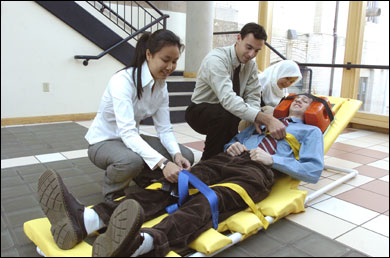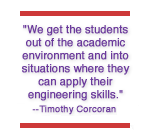|
|
||||
|
|
Students Demonstrate Next Big Thing in Biomedical Engineering Products
What's the next breakthrough product in biomedical engineering? If projects demonstrated by more than 30 Carnegie Mellon students are any indication, it could be anything from a high-tech stretcher for patients with spinal injuries to an electrical stimulator that eases facial paralysis.
The stretcher and facial stimulator were two of nine product prototypes demonstrated on campus May 9 as the finale for the biomedical engineering senior capstone course. The student projects could eventually be used by paramedics or emergency room physicians.
James F. Antaki, an associate professor of biomedical engineering and computer science, said the capstone course is designed to integrate science, engineering and other classroom knowledge to solve a practical bioengineering problem.
The student teams gave project presentations, including demos of each new biomedical tool created. The electrical stimulator for facial paralysis, for example, consists of a cigarette-sized electric unit and several face patches to monitor signals from a person's face. "One day this prototype could be useful for palsy patient research," Antaki said. Palsy is a condition marked by the uncontrollable tremor of the body or body parts.
Antaki, Corcoran and Stuart Weiler (shown above near head of stretcher), a senior in biomedical and mechanical engineering, also showcased the prototypes on KDKA-TV's "Business Page" hosted by John Delano last Sunday, May 8.
In the past three years, undergraduate enrollment in Carnegie Mellon's Biomedical Engineering Department climbed from 32 students to more than 160. Sixty students from the department graduated May 15.
Chriss Swaney |
||
|
Carnegie Mellon Home |
||||

 "We get the students out of the academic environment and into situations where they can apply their engineering skills," said Timothy Corcoran (E'00), a biomedical engineering alum and associate professor of medicine and biomedical engineering at the University of Pittsburgh. Corcoran was an advisor to the team that created the high-tech stretcher, which contains support mechanisms that allow a patient to be transported with greater ease and safety.
"We get the students out of the academic environment and into situations where they can apply their engineering skills," said Timothy Corcoran (E'00), a biomedical engineering alum and associate professor of medicine and biomedical engineering at the University of Pittsburgh. Corcoran was an advisor to the team that created the high-tech stretcher, which contains support mechanisms that allow a patient to be transported with greater ease and safety.